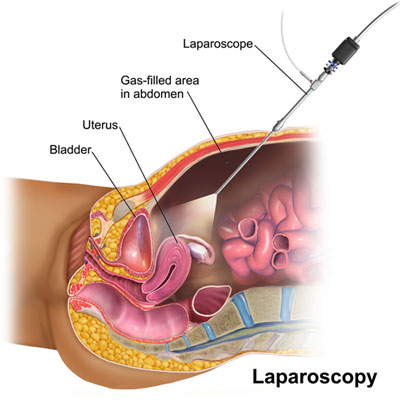LAPAROSCOPIC SURGERY
Laparoscopic surgery
Laparoscopy is a surgical treatment that has become the gold standard for patients suffering from unexplained infertility. Laparoscopic Infertility Treatment is used in the treatment for abnormalities in the uterus, fallopian tubes, and ovaries. Laparoscopic surgery, which employs light and a small camera to examine the pelvic anatomy for causes of female infertility, is performed by a fertility surgeon.

What Is Laparoscopic Infertility Treatment?
Laparoscopy is a surgical procedure that allows a fertility specialist to examine anomalies in the uterus, fallopian tubes, and ovaries that interfere with a woman’s ability to conceive. Laparoscopic Infertility Treatment involves inserting a small telescope and specialized surgical instruments through a small incision made below the belly button. The doctor uses a camera to observe the interior of the pelvic cavity on a video screen. The Laparoscopic Treatment Procedure usually takes between 30 and 45 minutes.
How is a Laparoscopy performed for Fertility Treatment?
In most cases, laparoscopy is conducted while under the influence of general anaesthetic. The patient is given general anaesthesia to make the surgery more comfortable for her. The doctor will make a small cut around the abdominal button once the anaesthetic has taken effect. The abdomen will subsequently be filled with carbon dioxide gas. After your abdomen has been filled with gas, a telescope or laparoscope with a light and a camera is inserted through the cut to inspect the uterus. The doctor can see the uterus, fallopian tubes, and ovaries during this procedure. Other delicate surgical devices may be used to repair the fallopian tube.
What are the conditions that can be treated laparoscopically to improve fertility?
Laparoscopic ovarian drilling will promote ovulation in women with Polycystic Ovarian Disease (PCOD). Laparoscopic ovarian drilling for PCOS eliminates the excess thickness around the ovary.
Tubal Obstruction Treatment:
The most common female infertility factor in tubal blockage. This obstructs the fallopian tube, preventing fertilisation and, as a result, pregnancy. When minor quantities of scar tissue or adhesions clog the fallopian tubes, Laparoscopic Surgery is the best approach to remove the blockage and open the tubes. The gynaecologist can assess the fallopian tube and make an incision at the end of the fallopian tube to open it using the Tubal Blockage Correction by Laparoscopy. When the fallopian tube has been severely damaged, doctors may propose removing it rather than attempting to repair it.
Laparoscopic Treatment of Ovarian Cysts:
The ovarian cyst is a collection of fluid in the ovary that is surrounded by a very thin wall. Women of all ages are affected by ovarian cysts. Laparoscopy can be used to remove the majority of cysts.
The wounds will be repaired with dissolvable stitches after the cyst has been removed. Laparoscopic Ovarian Cyst Removal is the most successful method of removing ovarian cysts since it is less painful and has a shorter recovery time.
Fibroids:
Fibroids, also known as uterine leiomyomas, are non-cancerous tumours that appear as a smooth muscular layer of the uterus. Fibroids are the most prevalent type of solid pelvic tumour in women. Approximately 70% of women reported experiencing this problem. The most common is gynaecological laparoscopy surgery to remove the entire uterus. It is the total fibroid treatment since it eliminates the possibility of recurrence
Advantages of Laparoscopic Surgery for Infertility
It enables the doctor to examine the organs inside the abdomen in detail in order to diagnose possible infertility disorders. In addition to diagnostics, laparoscopic surgery may be used to treat various reasons of infertility, boosting the odds of conception. It is also beneficial in the removal of endometrial deposits, scar tissue, and fibroids.
Side Effects
The following are some of the most often encountered complications:
- Irritation of the skin at the site of the incision
- Infection of the Bladder
- Adhesions
- Infection at the infection site
- The formation of hematomas within the abdominal walls.
Recovery Time
Because the surgery is performed as an outpatient, the patient is discharged the same day. If there are any difficulties, a hospital stay of 2-3 days may be recommended. A few weeks are required to fully recuperate after a Laparoscopic operation. Proper drugs will be administered to aid in the recovery process and to alleviate pain.
Can Laparoscopic Surgery Affect Your Chances of Getting Pregnant?
Many women are concerned about how Laparoscopic surgery would affect their chances of becoming pregnant. However, laparoscopy does not interferes with a woman’s capacity to conceive. In fact, it may only improve the patient’s chances of becoming pregnant.
Book an appointment with KK speciality clinic and hospital, best hospital for laparoscopic infertility treatment.
For appointments Call – 099307 75754
